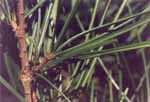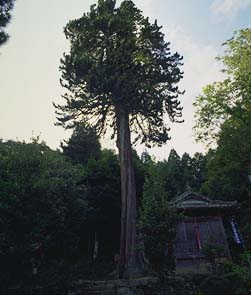
Male cone bud (1 cm diameter) in the Seattle arboretum [C.J. Earle].

1- and 2-yr twigs, and foliage on a tree in the Seattle arboretum. Image width
about 10 cm [C.J. Earle].
Common Names
Umbrella pine, Japanese umbrella pine (2), KOYA-MAKI [Japanese] (6).Taxonomic notes
The sole species in Sciadopitys Siebold & Zuccarini 1842. Basionym Taxus verticillata Thunberg 1784.Description
An evergreen tree to 20-30(35) m tall and up to 1 m dbh, with dense, heavy branching and luxuriant foliage, single- or multi-stemmed. Bark thick soft red-brown, stringy. Shoots orange-brown, glabrous, dimorphic (long or short); buds ovoid, 3-4 mm, only produced at the shoot apices. Leaves of two types, scale leaves on the stem, brown, 1-3 mm, widely spaced between the nodes on long shoots, and clustered in a tight spiral pseudowhorl subtending the photosynthetic leaves at the apex of both long and short shoots. Photosynthetic leaves variously interpreted as a pair of true leaves fused together, or as highly modified shoots (cladodes); linear, in pseudowhorls of 10-30 at the shoot nodes, 6-13 cm long, 2-3 mm wide, 1 mm thick, heavy, fleshy, pliable, with a prominent mid-line groove on both sides; rich glossy green with a pale stomatal line each side of the mid-line groove on the underside; persistent 3-4 years. Pollen cones 6-12 mm, in dense terminal clusters 1-2 cm across. Seed cones subsessile, ovoid, green ripening dark brown in 18-20 months from pollination, 4.5-10 cm long, 3.5-6.5 cm wide when open; fragile and breaking up soon after seed release. Fertile scales 15-40 per cone, thin, flat to upcurved, 2-3 cm long, 2-3.5 cm wide, rough, matt, with a broad flap-like transverse bract lateral across most of the width of the scale at its widest point; apex rounded, irregularly waved. Seeds 5-9 per scale, orange-brown, 8-12 mm long, flattened ovoid with a narrow wing along each side of the seed and notched at the apex. Cotyledons 2. Chromosomes n = 10. (4, 5, 6, 7, 8).Range
Japan: S Honshu, Kyushu and Shikoku. Occurs in mixed middle altitude cloud forest forest at 500-1000 m, with high rainfall and humidity (4, 6).Big Tree
A tree at Jinguji Temple, Koaza Himejitani Aza Ishikawa, Town of Nodagawa, Kyoto Prefecture is 27 meters tall and has a girth of 4.1 meters. "A tree with origins obscured in the distant past, historical records show that it has been worshipped locally since 1310, when a monk from Ishiyamatera Temple (in Otsu-City), renovated this temple located in the Ishikawa region and named it Jinguji Temple. Legend says the principal Buddhist image of the temple is a woman, which is why people, attending the annual festival, touch the Umbrella-Pine in hopes of being blessed with healthy children. The Umbrella-Pine of Junguji Temple has been designated as a natural monument (plant) of Kyoto Prefecture" (9).Oldest
See above (Big Tree).Dendrochronology
Ethnobotany
In Japan, the spicy-scented, water-resistant wood is highly valued for making boats; its bark, in the form of oakum, is used for caulking (2).It is one of the 'five trees of Kiso' treated as sacred in Japan (6).
Sciadopitys makes a very attractive ornamental, with luxuriant rich green foliage and orange-brown bark, but it requires high rainfall and warm, humid summers for good growth (USDA hardiness zone 7). Also, like Ginkgo ( Ginkgo biloba ), it is a good tree to grow as a 'conversation piece', with a history dating from the earliest days of the dinosaurs.
Observations
See above (Big Tree). Most botanical gardens and arboreta in subtropical to temperate climates will have specimens.Remarks
Listed as vulnerable. Despite the value of its wood, its slow growth has led to a decline in planting in Japanese forests in favour of faster-growing species like Cryptomeria japonica.It is an ancient endemic with a highly relictual range; the prehistoric range of the family was far more extensive across both Eurasia and North America, with fossils dating back to the upper Triassic. Among the oldest of all extant conifers, and already in decline by the time other 'ancient' conifers became widespread in the lower Cretaceous (4), it is a true 'living fossil'.
The English name 'umbrella pine' refers to the whorls of leaves resembling the spokes of an umbrella; the Latin Sciadopitys is a translation of this.
This species forms old-growth forests with Chamaecyparis obtusa . Seedlings can regenerate beneath the forest canopy, although small gaps with exposed mineral soils constitute preferred establishment sites (3).
Citations
(1) Silba 1986.(2) "umbrella pine," Britannica Online.
(3) Yamamoto, S.I. 1988. Seedling recruitment of Chamaecyparis obtusa and Sciadopitys verticillata in different microenvironments in an old-growth Sciadopitys verticillata forest. Botanical Magazine of Tokyo 101(1061):61-71.
(4) C.N. Page in Kubitzky 1990.
(5) M.P. Frankis, pers. obs. of cultivated trees in Britain, reported 21-Feb-1998.
(7) Rushforth 1987.
(8) Vidakovic 1991.
(9) Kyoto Nature: 200 Glimpses. URL=http://www.pref.kyoto.jp/intro/21cent/kankyo/200/jk30e.html, accessed 25-Jan-2000.
Thanks to M.P. Frankis for preparing the description and much supplementary material, Feb-1999.
[ Sciadopitys ] [ Sciadopityaceae ] [ home ]
This page is from the Gymnosperm Database
URL: http://www.geocities.com/~earlecj/sc/sc/index.htm
Edited by Christopher J. Earle
E-mail:
earlecj@earthlink.com
Last modified on 25-Jan-2000
